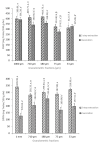Influence of Particle Size and Extraction Methods on Phenolic Content and Biological Activities of Pear Pomace
- PMID: 38231877
- PMCID: PMC10705881
- DOI: 10.3390/foods12234325
Influence of Particle Size and Extraction Methods on Phenolic Content and Biological Activities of Pear Pomace
Abstract
The main goal of this research was to investigate how particle size influences the characteristics of pear (Pyrus Communis L.) pomace flour and to examine the impact of different pre-treatment methods on the phenolic content and associated bioactivities. Pear pomace flour was fractionated into different particle sizes, namely 1 mm, 710 µm, 180 µm, 75 µm and 53 µm. Then two extraction methods, namely maceration with methanol and two-step extraction with hexane via Soxhlet followed by ultrasound extraction with methanol, were tested. Total phenolic and total flavonoid contents ranged from 375.0 to 512.9 mg gallic acid/100 g DW and from 24.7 to 34.6 mg quercetin/100 g DW, respectively. Two-step extraction provided antioxidant activity up to 418.8 (in FRAP assay) and 340.0 mg Trolox/100 g DW (in DPPH assay). In order to explore various bioactive properties, this study assessed the inhibitory effects of enzymes, specifically α-amylase and β-glucosidase (associated with antidiabetic effects), as well as angiotensin-converting enzyme (linked to potential antihypertensive benefits). Additionally, the research investigated antibacterial potential against both Gram-negative (E. coli) and Gram-positive (S. aureus) bacteria, revealing significant results (p < 0.05), particularly in the case of the two-step extraction method. This investigation underscores the substantial value of certain food industry wastes, highlighting their potential as bioactive ingredients within the framework of a circular economy.
Keywords: ACE; TFC; TPC; antidiabetic; antioxidant; pear pomace.
Conflict of interest statement
The authors declare that they have no known competing financial interest or personal relationships that could have appeared to influence the work reported in this paper.
Figures




Similar articles
-
Phenolic Compounds from Pyrus communis Residues: Mechanisms of Antibacterial Action and Therapeutic Applications.Antibiotics (Basel). 2025 Mar 8;14(3):280. doi: 10.3390/antibiotics14030280. Antibiotics (Basel). 2025. PMID: 40149091 Free PMC article. Review.
-
Biowaste as a Potential Source of Bioactive Compounds-A Case Study of Raspberry Fruit Pomace.Foods. 2021 Mar 26;10(4):706. doi: 10.3390/foods10040706. Foods. 2021. PMID: 33810427 Free PMC article.
-
Phytochemical Content, Antioxidant, Alpha-Glucosidase Inhibitory and Antibacterial Activities of Spineless Cactus Pear Cultivars.Plants (Basel). 2021 Jun 28;10(7):1312. doi: 10.3390/plants10071312. Plants (Basel). 2021. PMID: 34203366 Free PMC article.
-
Optimization Method for Phenolic Compounds Extraction from Medicinal Plant (Juniperus procera) and Phytochemicals Screening.Molecules. 2021 Dec 9;26(24):7454. doi: 10.3390/molecules26247454. Molecules. 2021. PMID: 34946537 Free PMC article.
-
Which Extraction Solvents and Methods Are More Effective in Terms of Chemical Composition and Biological Activity of Alceafasciculiflora from Turkey?Molecules. 2022 Aug 6;27(15):5011. doi: 10.3390/molecules27155011. Molecules. 2022. PMID: 35956963 Free PMC article. Review.
Cited by
-
Phenolic Compounds from Pyrus communis Residues: Mechanisms of Antibacterial Action and Therapeutic Applications.Antibiotics (Basel). 2025 Mar 8;14(3):280. doi: 10.3390/antibiotics14030280. Antibiotics (Basel). 2025. PMID: 40149091 Free PMC article. Review.
-
Effects of Particle Size on Physicochemical and Nutritional Properties and Antioxidant Activity of Apple and Carrot Pomaces.Foods. 2024 Feb 26;13(5):710. doi: 10.3390/foods13050710. Foods. 2024. PMID: 38472822 Free PMC article.
-
Physicochemical Properties of Dried and Powdered Pear Pomace.Molecules. 2024 Feb 5;29(3):742. doi: 10.3390/molecules29030742. Molecules. 2024. PMID: 38338485 Free PMC article.
References
-
- FAOSTAT. [(accessed on 9 August 2023)]. Available online: https://www.fao.org/faostat/en/#data/QCL/visualize.
-
- Ignatia F., Meivira K., Kartawiria I.S., Gunawan-Puteri M.D. Review: Nutrient, fiber, and bioactive content of fruit pomace, major by-product of juice industry; Proceedings of the 6th International Conference of Food, Agriculture, and Natural Resource; Virtual Event. 4–5 August 2021;
-
- Malhi N., Carragher J., Saarela M., Pahl S. A Review of Opportunities to Recover Value from Apple and Pear Pomace. Fight Food Waste Cooperative Research Centre; Adelaide, South Australia, Australia: 2021.
-
- Ross K.A., DeLury N., Fukumoto L., Diarra M.S. Dried Berry Pomace as a Source of High Value-Added Bioproduct: Drying Kinetics and Bioactive Quality Indices. Int. J. Food Prop. 2020;23:2123–2143. doi: 10.1080/10942912.2020.1847144. - DOI
Grants and funding
- FCT UIDB/04129/2020/LEAF- Linking Landscape, Environment, Agriculture and Food Research Center, Instituto Supe-rior de Agronomia, Universidade de Lisboa
- C64492956-00000040 (Project nº 37)/Project VIIAFOOD - Plataforma de Valorização, Industrialização e Inovação comercial para o AgroAlimentar - PRRI Aviso Nº 02/C05-i01/2022
LinkOut - more resources
Full Text Sources
Molecular Biology Databases
Miscellaneous

